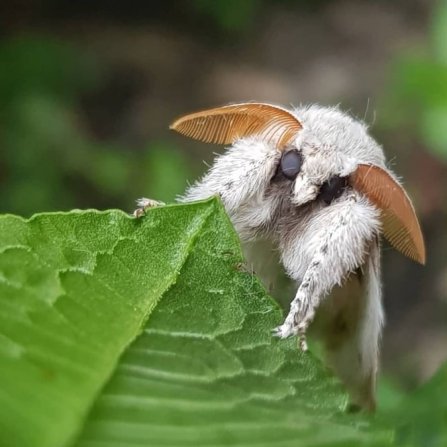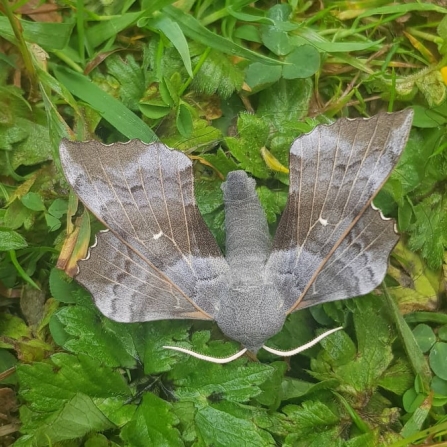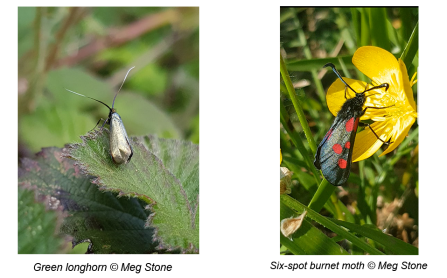Hello, I’m Meg and this weekend I took over Gloucestershire Wildlife Trust’s Instagram to talk about moths. I became increasingly interested in these diverse creatures whilst studying an MSc in Applied Ecology at the University of Gloucestershire.
There’s Nothing Like Moth-ing

Pale tussock
Now I’ll be honest I never thought I would become so fascinated by moths. I have always been interested in wildlife, but had never given moths much thought and considered them to be rather dull. This all changed when my dad’s friend gave me a moth trap a few years ago. I couldn’t believe the variety of shapes, patterns and colours of the moths that were in the trap and every single morning provided a different selection. I just thought it was absolutely crazy that all these different moths had been flying around my garden all my life and I had never known! I can remember how amazed I was when I got my first hawkmoths which were a pair of beautiful Poplar Hawkmoths (Laothoe populi)! I found it hard to identify moths at first but once I got to know which types of moths were certain shapes, I got to know which section of my ID book to turn to, which significantly narrowed it down. Some moths also describe themselves, like the White Ermine (Spilosoma lubricpeda), Speckled Yellow (Pseudopanthera macularia) or Treble Lines (Charanyca trigammica), which is very helpful!

N.b. If you’re thinking, ‘Trapping? That doesn’t sound good!’ Then don’t worry moth traps don’t harm moths. The moths are just attracted to the light and then rest in the trap until I identify them and release them in the morning.
The more moths I’ve seen, the more I wondered why on earth their abundance and diversity wasn’t known to me when I was growing up. They just seem to be missing or at least not the main focus of children’s wildlife ID books and nature documentaries. Even people that work in environmental education and fellow ecologists have seemed surprised to learn that I have a keen interest in moths! With this in mind, last year (2019), I decided I wanted to change how overlooked these insects are and so I created an Instagram account dedicated to moths (@megs_moths). I thought if I shared pictures and information of these beautiful creatures, I would hopefully be able to raise awareness of them and this might help conserve their numbers.
Perfect Pollinators
When we think of pollinators we might think about bees and butterflies, and maybe hoverflies, but how often do we think of moths? With over 2,500 species of moth in the UK – more than the number of bee, hoverfly and butterfly species put together – it really does baffle me that they are often left out of the ‘important pollinator club’. Regardless of their beauty, diversity, or useful pollination service, it’s the fact they are so often overlooked that makes me want to hark on about them to anyone and everyone! I suspect the reason for them falling under the radar is to do with the fact that most of them aren’t up and about when we are. Typically, what’s out of sight, is out of mind! Just imagine though, if we had a few of these moths (see below) visiting flowers in our garden during the day! I reckon we’d all appreciate them a lot more and be looking for moth-friendly plants in the garden centre. That just doesn’t sound right though, does it? Moth-friendly plants? You may have heard of bee-friendly, but moth-friendly? Well, some plants are attractive to many different pollinators, but certain plants have evolved to produce more or all of their scent at night, specifically to attract moths! Honeysuckle is a great example of a night-scented plant which can be smelt by moths from a quarter of a mile away and is a particular favourite of the Elephant Hawkmoth (Deilephila elpenor).

Elephant hawkmoth
A recent study found that moths are responsible for pollinating a wider variety of plants than daytime pollinators, such as bees. And like bees, moths have also suffered large declines, which is worrying for other wildlife such as birds and bats which rely on moths and their caterpillars as a key food source! The decline of the Cuckoo is thought to be linked to the decrease in Garden Tiger moths (Arctia caja), as the caterpillars are a key part of the Cuckoos diet.
Random Acts of Wildness for Moths
You’ll be glad to know there are several acts of wildness that can encourage these vital pollinators into your garden, as part of 30 Days Wild!
Let part or all of your garden grow wild. You might have heard of ‘No Mow May’, well why not keep that up throughout June and July or for as long as you like! This will be beneficial to all kinds of wildlife. You’ll be amazed by the amount of different plants that will start to grow in your garden! It might look a bit untidy but think of it more as a vital wildlife refuge.
Instead of tidying away or composting any plant debris, leave it in your garden to provide shelter and overwintering sites for moths. If you’re worrying about your garden looking messy then creating a pile of plant debris at the back of a flower bed would still be beneficial!
If you have space to do so, planting a hedge full of native plants such as Hawthorn, Blackthorn and Privet will create a perfect habitat for many species of moths. Hedges not only provide moths with shelter from predators, but they also provide caterpillars with plenty of foliage to feed on.
There are a wide range of plants that adult moths and their caterpillars feed from so it’s best to have a mixture of large and small flowering plants plus a few shrubs. These include Buddleias, which are great for day-flying moths, Honeysuckle, Pinks, Night-scented Stocks, Knapweed, Scabious and Evening Primrose. Ivy, Michaelmas Daisies and Sedum spectabile are particularly good for moths flying in Autumn.
Flowers with nectar are a good source of food although some adult moths don’t have mouthparts so don’t actually feed at all, such as the Poplar Hawkmoth!

Poplar hawkmoth
Day-time Flying Moths
You might be surprised to know there are more species of moths that fly during the daytime than the number of butterfly species we have in the UK!
Some of the best sites to see day-time flying moths in Gloucestershire are Crickley Hill Nature Reserve, where I’ve seen many different species including Speckled Yellow and the beautiful Green Longhorn (Adela reaumurella) micro-moths. Cleeve Hill and Pittville Park are also great sites that have some beautiful daytime flying moths such as Cinnabar (Tyria jacobaeae) and Six-Spot Burnet (Zygaena filipedulae)! If you visit any of these sites or another area in Gloucestershire and manage to get a picture of any moths, please share them on Facebook, Twitter or Instagram using the #glosmothspots. Some of these moths might even be in your garden or local park! You can contribute to citizen science by sending your sightings to the county moth recorder or uploading them onto iRecord or iNaturalist.
I’d love to see what you find, so good luck and happy moth-ing!


